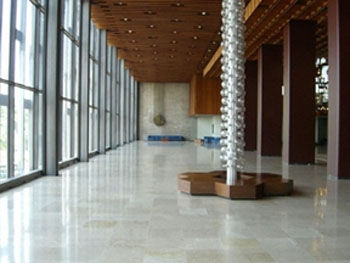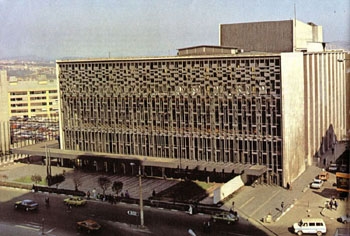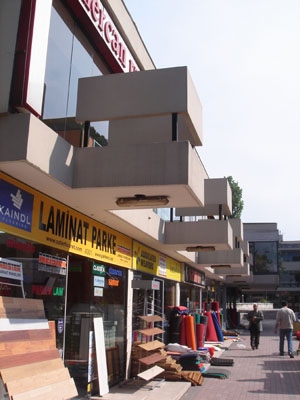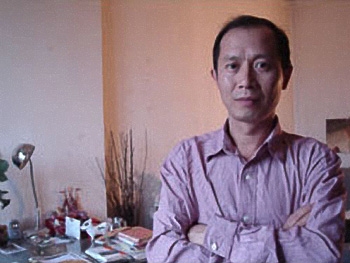
AKM—Ataturk Kultur Merkezi (Ataturk Cultural Center) AKM was designed by Hayati Tabanlioglu and opened in 1969 as the "Istanbul Cultural Palace." It was closed to the public after a fire in 1970, and then was renovated and reopened as the Atatürk Cultural Center. It contains two large halls for performances and concerts and houses galleries on its top floor.

AKM—Ataturk Kultur Merkezi (Ataturk Cultural Center) AKM was designed by Hayati Tabanlioglu and opened in 1969 as the "Istanbul Cultural Palace." It was closed to the public after a fire in 1970, and then was renovated and reopened as the Atatürk Cultural Center. It contains two large halls for performances and concerts and houses galleries on its top floor.

IMÇ—Istanbul Manifaturacilar Carsisi (Istanbul Textile Traders Market). The IMÇ building complex which covers an area of six blocks, integrated concepts of modern architecture and urban design when it was built in the 1960s. Today it contains over one thousand shops, from textile related companies to music producers and musical instrument shops.
Feature: Conversations
Hou Hanru in Conversation
Hou Hanru, curator of the 10th International Istanbul Biennial which is scheduled to open in September 2007, speaks about the themes and topics that will shape his curation of this event. Hou Hanru is currently the Director of Exhibitions and Public Programs at the San Francisco Art Institute. He most recently served as the artistic director of the 2nd Guangzhou Triennale where he co-curated Beyond: An Extraordinary Space of Experimentation for Modernization with Hans-Ulrich Obrist and Guo Xiaoyan (Guangzhou, China 2005). Other recent curatorial projects include Go Inside, the 3rd Tirana Biennale (Tirana, Albania, 2005),Out of Sight, organized by the De Appel Foundation (Amsterdam, Netherlands, 2005), Nuit Blanche 2004 (Paris, 2004), and A L’Ouest Du Sud De L’Est / A L’Est Du Sud De L’Ouest (Villa Arson, Nice, 2004).
Berin Golonu: The title of the next Istanbul Biennial is “Not Only Possible But Also Necessary: Optimism in the Age of Global War.” What kinds of hopeful alternatives to our current reality does it suggest?
Hou Hanru: It suggests that it is important to improve our conditions rather than to only complain, and that in a time of global conflicts, one can also be an optimist. I have always been interested in modernity, and in how different cultures can generate different modernities to realize their own ideals. Turkey has a very interesting and contradictory history. It was the center of western culture (civilization) several hundred years back, even a thousand years back. Byzantium was regarded as an important metropolis. Then eighty years ago, Turkey became one of the first secular republics. It has the most radical vision of revolution and modernization, yet it has constantly been rejected from the West. Turkey’s struggle to be a part of Europe and the negotiations between Europe and Turkey symbolize a lot of today’s global tensions. All this tension creates a very interesting dynamism in the contemporary culture. The Istanbul Biennial can be considered part of this global dialogue. The desire on the part of the Turkish art world to become a part of the global contemporary culture, and the desire to establish a national position.
BG: You talk in your catalog essay for the exhibition Cities on the Move (co-curated with Hans-Ulrich Obrist) about the tension that exists between a capitalist economy introduced by modernity and the traditions of Asian culture. Will this topic be examined in this Biennial, and if so, how do you think that this tension is reflected in a Middle Eastern metropolis such as Istanbul?
HH: Historically, Istanbul is even more complicated in terms of its relations with modernization, the West, and the global economy, than most of the Asian cities that we talked about in Cities on the Move.
BG: I’m curious to hear the differences.
HH: The people who live in Istanbul who have grown up under western influence think Istanbul is a European City. On the other hand, Istanbul has also seen the most radical expansion since the 1970s because of its modernization and its integration into the global economy. People from the rural, eastern part of the country have been moving into the city. This brings a new complexity into the already complicated structure. This tension has a longer history than cities like Shanghai, or Kuala Lumpur or Singapore. On the other hand, historically, Istanbul has always been a multicultural playground. That is not the case in East Asian cities. With East Asian cities, integration into the global situation comes later, after the 1990s, whereas somehow Istanbul has deep roots in integration. Due to Turkey’s complicated negotiations with Europe, Istanbul is searching for its own position as a leader of the Middle East. This creates an interesting dynamism and a modern internal conflict. What kind of a national identity should Turkey have? Is it an Islamic country? A modern country? Or a European country? These questions reflect the every day debates of the people.
BG: How will these debates be reflected in the project of the Biennial?
HH: The Istanbul Biennial was created in the early eighties and became the second most important non-western Biennial after Sao Paulo. The creation of the Istanbul Biennial as well as the creation of the IKSV, the cultural foundation that organizes the Biennial, reflect a contradictory and dynamic process: that Turkey wants to be a part of the international art world, but at the same time, it wants to claim its own position.
BG: But don’t specific locales feel the need to claim their own position for fear of falling prey to the homogenizing influences of globalism?
HH: Yes, but the people who helped create the Istanbul Biennial are mostly from Europe. People like Rene Block or Sarkis, who travel to Istanbul, bring back a lot of influence from Europe as a way to create a real contemporary art scene there. And as a result, the contemporary art scene in Istanbul has grown to real maturity these days. There may not be a market for contemporary art in Istanbul, but there is nonetheless a lively art scene.
BG: Turkish collectors do seem to only buy traditional painting and sculpture.
HH: Yes, that is what the contemporary bourgeoisie likes, but contemporary art still doesn’t have a market. But thanks to the Istanbul Biennial and the efforts of other local curators, critics and artists, Turkey is now on the global art map and there are quite a few Turkish artists showing in major international events. So I think that the Biennial itself has been successful in achieving that goal. Now we are getting to a period when we have to look for new models.
BG: Right, there seems to be a constant need to reinvent curatorial models in order to keep the biennials fresh and to look beyond the traditional channels for new artists and new types of work. How will you reinvent the model of the next biennial?
HH: Reinventing is too strong a word. I wouldn’t say that I am reinventing anything. However, we are undertaking some new experiments. As a tradition, the Istanbul Biennial has never had a stable venue, but has always been integrated into different venues.
BG: I know that previous curatorial models used monuments of antiquity for the presentation of contemporary work. But Vasif Kortun and Charles Esche, the curators of the last Istanbul Biennial, focused instead on centers of commerce and industry that highlighted the working life of a city.
HH: Most biennials have looked for a connection between contemporary art and the exotic locations of a city, which is fine, but if we talk about a real contemporary reality, then you have to deal with the history of modernity in a city. Vasif and Charles were not really talking about modernity as much as every day life. They wanted to get rid of the exotic reading of the city, and bring people to the every day life of a city, which was very successful. As a result, their Biennial marked a certain turning point. This time I’m thinking of shifting the focus to rediscuss the grand discourses around the questions of modernity, geopolitical conflict, and urban space. So I decided to use venues with a link to the history of modernity.
For example, one of the 5 or 6 venues I have chosen is the Ataturk Cultural Center, a building that was built in the 60s to commemorate the founding of the republic. This place is thought to look poor and shabby, and there is a debate about whether they should demolish it or renovate it. This shares a very similar destiny with a lot of revolutionary buildings in Eastern European countries, as well as in Russia. Take, for example, the Place de la Republic in Berlin. They decided to demolish that building and replace it with a fake antiquity by reconstructing a palace that was there before the revolution. This shows how the most conservative kind of global capitalism is destroying the history of modernity. Taking into consideration the whole idea of public space and non religious democracy, the destiny of a site such as the Ataturk Cultural Center becomes a very important thing. I wanted to articulate this, so I’m going to use that site’s lobby space to display projects that address the theme of utopia.
The other venues I’m choosing are located in different parts of the city and are equally important to the history of modern architecture in Turkey. Each of the venues will have a specific curatorial project with a different theme. The Antrepo will have an exhibition titled “Entropolis,” which will be about global trade, immigration, borderlines and how the polis is replacing the notion of a nation state. We will also make use of a new venue built by Istanbul’s Bilgi University called santralistanbul. It’s a centuries old power plant that is being transformed into a contemporary arts center and energy museum. The Biennial will use santralistanbul as a kind of laboratory and workshop environment where artists, students and the public can come together around discussions and lectures. Another venue that has never been used before, called the IM« Buildings, is a block long structure that houses workshops, boutiques, and other artisan shops. IM« will host projects under the theme “World Factory,” that talk about questions of production. Turkey’s recent history has to do with contributing to the world economy by turning itself into a factory for the world. The notion of the ìworld factoryî has been used by economists and sociologists who talk about the third world’s role in the global economy, and how it becomes a factory for the world market. In many places like in China, Vietnam, Korea and Taiwan, all of these new economies are living through this process of first becoming a factory of western products, and then establishing their own economies to then become major players in the global economy.
BG: With the 9th International Biennial, Vasif Kortun had more of the view of the insider, since he was a longtime resident of Istanbul, and Charles Esche had the view of the outsider, since he is a European to who travels to Istanbul more like a cultural tourist. Yet these two views came together in a complementary manner in their show. I wanted to ask you how you were going to bridge such a divide.
HH: I’m thinking that a biennial should not only be an exhibition only for the international art public. I wanted to position myself as someone living there, and at least do something for the people who live there. The most important goal for me is how people in Turkey will use this event to get to the next step of creation. I decided to do the program in two parts, a day program and a night program. A couple of years ago in Paris, I did a project called “Nuit Blanche,” or “White Nights.” On the first Saturday night of October, once a year, the city is turned into a huge exhibition space for contemporary art. So what I did was to have an open competition for video works. Whoever, no matter who they were, sent in their work and we selected 100 videos and showed them on a 200 meter long screen outside. I’d like to do something similar in Istanbul, but in different parts of the city. I want to bring a new democracy into contemporary art through something like this, but also to embrace new technologies. It will be an open competition, and the selection will be made by a group of young Turkish curators.
BG: One of the questions I wanted to ask was whether you were going to use any local curators in the process of selection.
HH: I really want to provide the possibility for this to happen during the whole biennial, which will last 2 months. And these screenings will happen in the street. When you do a night program, you have to think about if people want to sleep, if they want to dream, or if they want to make love. We just located a building for the screenings in a newly developed area near the military museum. It’s a parking lot on the roof which is a funny structure. The upper parts look like they are floating. So I want to call it a dream house. I want some artists to do some site specific projects and installations where people can play on them, lie on them, sleep on them. Or maybe sound, music and image can be projected on them. Now I’m working with a couple of architectural groups and urban planners to see how we can explore venues on the Asian side of Istanbul, not just on the European side. The biennial will be an event that will integrate itself fully into the city. It will also integrate itself into the real process of modernization. How much one can still explore this history of modernization is a possible and necessary project for the future.
BG: It’s definitely a forward looking project.
HH: Yes, it should also propose that the idea of modernity and a better future is not only a western notion, that it is shared by different cultures, and that every culture produces its own vision. It’s time to show this to the public. This is why I needed to give it such a long title.
BG: Do you think the Western world can learn anything from the developing world’s process of modernization?
HH: Sure, guys like Rem Koolhas are always looking to the East. He has asked me why I moved to the U.S. from Europe. I told him it’s because I can get to the Asia Pacific easier from San Francisco. In fact, Europe and the States are reaching their ultimate saturation point, so the new dynamism comes from places like Shanghai, Dubai, Lagos, Johannesburg or Sao Paulo. You have problems in these places, but you also have dynamism and you have desire. People still believe in the future. Because of this, they generate very different models of cities. In Paris, you can never imagine a change in the structure of a city, but in places like Shanghai or Dubai, they are going through a period of complete invention. They can do anything, because there is a need, there is a desire, and there is a competitiveness to prove that they exist in the world. They can offer us new possibilities to envision what we are doing in a very different way. That’s what I am hoping to say through this Biennial project.
An edited excerpt of this text was originally published in the October 2006 issue of Flash Art magazine.

